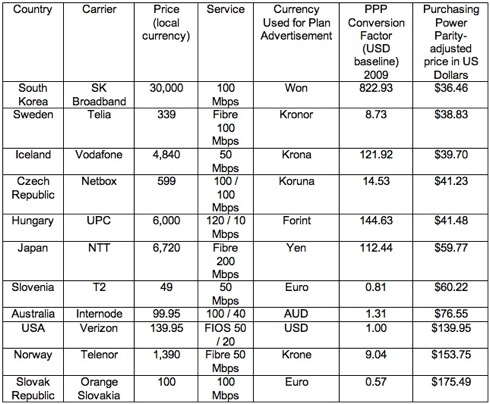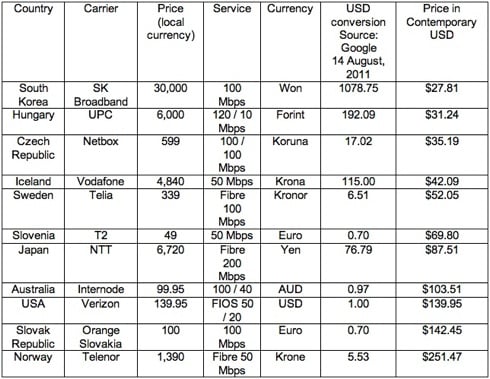This article is more than 1 year old
How expensive are Australian NBN services?
Depends on how you measure it
One of the things people like to toss into the broadband debate is to grab a price that’s cheaper than what Australia’s National Broadband Network seems to offer, and complain about it.
Usually, that involves grabbing a price in a currency other than our own, grabbing today’s exchange rate, and converting the foreign price. And there’s always something wrong with this: it ignores factors external to the exchange rate.
To pick a nearby example: while we can easily convert Australian dollars to American – so long as our calculator runs faster than current fluctuations in the exchange rate! – that conversion ignores the different average wage (about $AU1,300 here, $US800 there). Twenty dollars makes a bigger hole in the American than the Australian pocket, right now.
So I’m going to compare a few fibre broadband offerings in different countries based on a more complex measure, that of “purchasing power parity” (PPP). A table of broadband prices adjudged this way is below.

Australia is paying over the median price for a 100 Mbps broadband service (recalling that to put us at the greatest possible disadvantage, I have picked a premium service provider). There are seven services offered cheaper than Internode; only three are more expensive.
But is it really so bad? Here are a few points.
1. All of the countries offering lower prices than Australia for a 100 Mbps service are much smaller than Australia, with consequent geographic advantages.
2. Two services more expensive than Internode’s are not 100 Mbps, but 50 Mbps, because that’s what the carriers offer.
3. The Slovak Republic gets 100 Mbps services (upload speeds not mentioned), but for more than double the Australian price.
4. Internode is explicitly a premium provider. I selected its price because I don’t know who rates as premium providers in other countries – I didn’t want to compare the cheapest price from Australia with the most expensive overseas. The cheapest NBN-delivered offering today is from Exetel which, at $AU49.50, is below the international median by any measure.
And finally, I don’t remember anybody ever promising that Australia would get the cheapest broadband in the world. Such a promise would be completely incompatible with at least three characteristics that are specific to Australia:
1. Our size and population density. If we want to get even close to equitable access to broadband, a city-country subsidy is inevitable.
2. Unlike non-English-speaking countries, most of the content we consume comes from overseas, so our network builds in a premium for international links.
3. We’re charged heavily for US Internet transit.
All things considered, the prices don’t compare too badly on an international basis.
Methodological notes
Before any economists yank the leash, I will admit that PPP also has problems. Two are particularly apposite here: first, that there is no perfect basket of products that will accurately reflect the purchasing power of a salary in different countries (not even the famed Big Mac Index); second, that because PPP is a complex calculation covering hundreds of countries, it has a considerable lag behind currency fluctuations.
But that’s okay: PPP is, in this context, used only as a model. Any model is inaccurate: the problem comes when people believe more in their models than they believe in reality.
At the very least the PPP adjustment is an attempt to take purchasing power into account, thereby offering an attempt to reflect not just “how much does this cost in US dollars / Australian dollars?” but “how big a dent does this put in the wage-earner’s pocket?”
For this exercise I have used the Penn World Table (here) as the source, and the most recent available date (2009). For broadband prices, I compare the NBN service prices from Australian carrier Internode – not the cheapest offering on the NBN – to the top ten users of fibre according to OECD broadband statistics.
I haven’t tried to cover every country offering fibre; to do so would have been a huge effort for little extra information.
Finally, I admit that I have only taken one price point per country. But I’m not asking anyone to make a business decision based on this data. It’s a discussion paper only; a way to try and offer a different perspective than we can get if we over-simplify the debate.
So that nobody tells me that it would be more accurate to use today’s exchange rates, here’s what happens if I convert all the prices to US dollars:

Australia’s position on the table didn’t change: we’re still in the top quarter for price – if you assume that Internode’s rate is an accurate benchmark for the whole country.
So yes: our fibre broadband (at the top of the market) is “more than triple the cost” of South Korea’s. Our wages are also higher, our country bigger, our houses bigger, and we don’t have a nervous, paranoid, starving, unstable, dangerous neighbour within artillery distance of our border.
I think we’ll survive. ®
